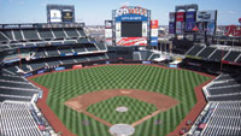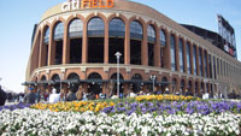
Security Watch: Securing Sports Arenas
Jul 1, 2007 12:00 PM,
By Bret Bass
Recent technology offers a new level of protection.

Panasonic’s new breed of Super Dynamic III intelligent digital cameras, such as the
WV-CW964 pictured above, provide auto image stabilizer, scene change detection, and auto tracking.
In March 2005, the Department of Homeland Security (DHS) released a document titled “National Planning Scenarios,” which offered estimates of probable death and economic damage that could be caused by various types of terrorist attacks. In that report, sports arenas ranked among the top 12 strike site categories considered most plausible and most devastating. That’s why manufacturers such as Panasonic and Lenel have been developing cutting-edge security systems for these venues in recent years, offering a new level of protection for visitors and a new market opportunity for systems integrators.
Since the public release of the DHS report, sports arena operators have made serious efforts to upgrade security systems and safety protocols. With 85 percent of the nation’s infrastructure protected by the private sector, and because government programs require a great deal of time to allocate funds needed to protect these facilities, immediate and profitable opportunities await installers.
Although the “National Planning Scenarios” reads like a doomsday prophecy, administrators of sports arenas also have to deal with far more prevalent — and less apocalyptic — security scenarios every day. Occasional outbreaks of fighting or abusive acts from fans are two examples, and then there are issues of internal theft, facility safety concerns, and constant access and crowd control considerations, not to mention a myriad of other potential crises waiting in the wings.
Whether a security matter springs from the threat of terrorism or the insobriety of diehard fans, safeguarding every guest in attendance at an event is a difficult, daily undertaking for any arena operator. Every sports center maintains and manages its own staff of security personnel, but with nightly crowds of 18,000 people or more, security officers obviously can’t be everywhere at once. They need the additional resources of accessible, reliable, and high-quality security technologies to help them meet their goals.
ACCESS CONTROL AT STAPLES CENTER
The Staples Center in Los Angeles provides a good example of how high-end access control systems enable a 900,000-square-foot facility to regulate guest, employee, and vendor access; issue ID badges; and conduct other visitor management functions, such as after-hours administration of custodial or delivery crews.
Experts generally agree that the Staples Center boasts one of the most sophisticated and comprehensive security management programs of its kind. As its system of choice, the Staples Center opted for the Lenel OnGuard ET system, which provides a centralized interface to access control, credential management, digital video surveillance, asset management, intrusion detection, building automation, and fire alarm systems.
The latest OnGuard platform contains numerous enhancements that have earned Lenel bragging rights as an industry leader. The new LNL-2220 intelligent dual reader controller, for instance, simplifies system architecture by combining a networked system controller with a dual interface module. The LNL-3300 intelligent system controller now offers 32MB of memory — four times more than a fully expanded controller from the previous generation, but with a much smaller footprint. Lenel has also outfitted both controllers with Ethernet connections, enabling direct communication with the security server. Native Ethernet controllers offer users the speed and convenience of a high-speed network connection, while increasing data downloads up to eight times faster than controllers using traditional serial-to-Ethernet conversions.
The OnGuard system also includes state-of-the art intrusion detection systems, which have macro-enabled features to allow the assignment of reader commands to hotkeys, full support for HID MIFARE encoding to further enhance the system’s unique ability to program badges on demand at the point of use, Bioscrypt product integration, and an overhauled video surveillance platform, complete with a new line of cameras and remote web viewing over a secure Internet server for authorized offsite users.
For Security Solutions, a California-based systems integrator and Lenel reseller, performing and managing the entire Staples Center retrofit and OnGuard installation was an incredibly lucrative contract. Staples Center executives knew what product they wanted, and Security Solutions was authorized to deliver.

The Honda Center replaced its ID cards with the Schlage Recognition Systems HandKey II biometric hand reader for greater access control.
SECURITY AND SURVEILLANCE AT THE HONDA CENTER
Systems integrator JMG Security and manufacturer Panasonic found similar success in another southern California sports venue — the Honda Center in Anaheim, Calif. Located about 30 miles south of the Staples Center, the Honda Center is the 650,000-square-foot home of the National Hockey League’s Stanley Cup Champion Mighty Ducks. JMG Security has been involved with security systems at the arena since construction on the facility began in 1991, but thanks to JMG’s relationship with pioneering manufacturers such as Panasonic and Bosch, the company was also awarded the contract to conduct a large-scale upgrade to the facility’s security systems when Honda acquired the naming rights from Arrowhead Water in October 2006.
As a result, the Honda Center’s overall security management system now includes the latest in digital video recorders, dome camera systems, and biometric access control scanners — creating one of the most comprehensive surveillance programs of any sports arena. Panasonic dome cameras are the driving force behind the operational success of the arena’s surveillance system.
On the roof of the facility sit four Panasonic dome cameras that provide complete 360-degree coverage of the parking lots. “The picture quality [of the cameras] is excellent [and] very clear, even when zooming in on distant objects. They are excellent,” says Russell Beecher, security and public safety manager at the facility.
These vandal-resistant outdoor dome units are highly regarded as among the most advanced dome cameras on the market. Panasonic’s new breed of intelligent digital cameras, the Super Dynamic III line, have achieved “unprecedented realism” with high-performance features such as the pixel-based 128x dynamic range. The 360-degree high-speed PTZ cameras also offer unmatched functionality with enhancements such as auto image stabilizer, scene change detection, and auto tracking. According to Panasonic, the cameras were designed for a variety of targeted security applications, including parking lots, sports arenas, amusement parks, shopping malls, airports, and train stations. The use of the Super Dynamic III line of surveillance products would therefore seem a natural fit for the Honda Center.
The Honda Center also strengthened its access control policies by replacing ID cards with Schlage Recognition Systems HandKey II biometric hand reader. The system employs a combination of a four-digit PIN number and a biometric reading of the contour and dimensions of a user’s hand to secure sensitive areas of the facility. Honda Center claims that the machine has never experienced a false read and that master keys are no longer necessary throughout the site.
With the number of lives at stake, the value of the property, and the value of assets such as specialty merchandise, cutting-edge surveillance and access control systems help the Honda Center protect its business and its customers. And for JMG Security, the authorized installer, the Honda Center upgrade presented a business opportunity that would make any systems integrator envious.
There are more than 300 indoor arenas alone in the United States, each seating between 5,000 and 18,000 people. All of these venues are looking for the right systems integrators with the best video surveillance, access control, and intrusion detection products. Remember, your market is only as limited as you make it, and this one is clearly ripe for the picking.
Bret Basshas been a security industry specialist for the last 16 years, focusing on the development of interactive and investigative systems such as video surveillance, access control, and remote monitoring.








